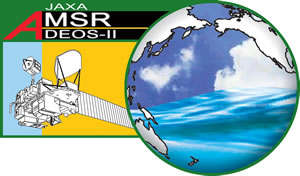Japan Aerospace Exploration Agency Earth Observation Research Center ALL RIGHTS RESERVED.

The Advanced Microwave Scanning Radiometer (AMSR) is a multi-frequency, dual-polarized microwave radiometer that detects microwave emissions from the Earth's surface and atmosphere.
Various geophysical parameters, particularly those related to water (H2O), can be estimated from AMSR data.
In addition to the proven parameters such as water vapor, precipitation, and sea surface wind speed, novel geophysical parameters, including sea surface temperature and soil moisture, are expected to be retrieved by using new frequency channels.
The largest ever microwave radiometer antenna enables us to perform continuous global observation with high spatial resolution.
Long-term record of AMSR measurements will play an important role in climate change monitoring as well as in providing indispensable information for understanding the Earth's climate system, including water and energy circulation.
Near real-time products will be used for investigating satellite data assimilation into weather forecasting models and will contribute to improving forecast accuracy.

AMSR was launched on board the Advanced Earth Observing Satellite-II (ADEOS-II) in 2002.
ADEOS-II is an integrated observing platform with multiple sensors covering the spectrum from visible to microwave frequencies.
In addition to AMSR, a combination of these sensors will provide a means of examining the Earth's phenomena from various aspects.
An AMSR follow-on series is being studied for the Global Change
Observation Mission (GCOM) as one of the core instruments to contribute to the long-term global monitoring.
The GCOM series, including the ADEOS-II, will enable constructing a 15-year satellite climate record.
The AMSR project is an international activity with scientists and engineers collaborating worldwide in algorithm development and data validation.
|
|
AMSR Sensor Characteristics AMSR Orbit |